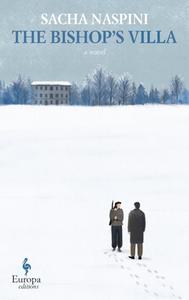
 Sacha Naspini (Nives) brings close and poignant attention to true events with his historical novel The Bishop's Villa, translated from the Italian by Clarissa Botsford.
Sacha Naspini (Nives) brings close and poignant attention to true events with his historical novel The Bishop's Villa, translated from the Italian by Clarissa Botsford.
In the fall of 1943, in the sleepy village of Le Case in Tuscany's Maremma region, a cobbler goes about his daily business. Solitary and quiet by nature, René makes do with just two fingers on his right hand following a childhood accident with a lathe; his nickname in town is Settebello, after the "lucky seven" card in scopa. When the local bishop rents out the seminary and surrounding villa to be used as a prison camp for the region's Jewish population, Le Case mostly plods on as before. Some local residents speak cruelly of the prisoners; many simply ignore their presence. René mends the shoes brought to him for repair by prison guards. For most townspeople, the war is poverty, deprivation, and the passage of time.
But René's neighbor Anna, a lifelong friend, has just lost her son, who fought for the Resistance until he was captured and executed by the Wehrmacht. Anna is galvanized; René wants her to stand down. And then Anna vanishes, leaving behind a note for René. She has gone to join the partisans, to "fight for Edoardo and for Italy." When René learns that Anna might have become imprisoned in the bishop's villa, he finds that he can no longer fail to act. His subtle sabotage begins with boots. "He chose rusty nails, some so brittle that they crumbled at the first blow. He hammered them in a little crooked, curved inwards as if he were aiming for the heel... the hole in the sole would get wider, like a small surface wound."
In short chapters, Naspini draws readers into René's world: first the tightly confined life of the village cobbler, traveling back and forth between home, workshop, and Anna's apartment, and then to the tighter confines of a cell in the bishop's villa. Botsford's translation is terse and atmospheric, punctuated by lyrical or romantic phrasings: wonder is "like a child unable to describe a treasure they'd chanced upon under a stone." With torture, "you can chew [a man's] bones clean, but you can't touch his soul, which means you will never win."
The Bishop's Villa is absorbing, transporting, beautiful, and grim. Naspini's Author's Note makes clear his drive to lay bare a shameful chapter of history; but with this novel he has also written a love story, for without Anna, "René would never have used the tools of his trade to fight his war." The result is moving and layered. --Julia Kastner, blogger at pagesofjulia
Shelf Talker: In this transporting novel based on real events, a shy cobbler in an Italian village during World War II is gradually drawn into quiet acts in the Resistance.

